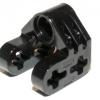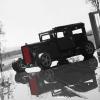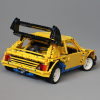Search the Community
Showing results for tags 'rc motor'.
Found 16 results
-
You can find a sneak preview od the 3D printed sample on our IG: https://www.instagram.com/p/CLAKIt3B0PG/ Performance is around 10% faster RPM and torque compared to the 5292 motor (cca 20% more power). The polyfuse protection will be increased from 0,9 A to around 1,35 A - still testing the balance between performance and longetivity. Improved attachment possiblities, everything fits as it should in the studless building system The final version color will be between LGB and DBG. It will come with a 30 cm long PF cable plug, so it's compatible with BuWizz 2.0 and PF. Preorder here: https://buwizz.com/shop/buwizz-motor/ More info when it becomes available.
- 30 replies
-

Tiger 4 x 4 x 4
Zerobricks posted a topic in LEGO Technic, Mindstorms, Model Team and Scale Modeling
After completion and playing with the Leopard for a few months, I noticed the model had a few shortcomings which I wanted to eliminate with this version. These include: Suspension oscilations at high torque High center of gravity Instability on rough terrain at high speeds Most of these issues were due to the usage of the torque tube suspension which is simply too heavy and unresponsive at high speeds. What I needed was to replace the live axle suspension with independent suspension while keeping the articulation needed for offroading. Here's what I came up with: Let's break down the suspension to it's basic components to better understand how it works: Colored green are the main shock absorbers. These caryy most of the wight and provide a high suspension travel Colored orange are the gearbox transfer arms which fix each perpendicular gearbox firmly to the suspension, thereby reducing friction and fixing the U joints to keep them from popping out. Colored black are the side beams which help guide the transfer arms and hold the suspension together Colored in red and gray are the two independent drivelines powering the wheels. Finally in transparent, the suspension arms are made as long as possible for maximum suspension travel. I built the first version with this setup, but soon discovred a flaw. The torque from the drivelines would push the suspension arms down, causing the suspension to stop responding (indicated with red and grey arrows in photo above). In order to solve this problem I added the suspension bridge above, colored in pruple. The suspension bridge performs the following functions: Compensation of the driveline torque Supports 20% of the model's weight Improves articulation when going over rough terrain With the suspension solved, I turned my attention to the chassis. I wanted a model with high torque and high speed. To achieve that I installed a two speed gearbox for each independent driveline powered by a total of 4 RC motors: Finally a very sturdy chassis based on frames was built to support the model. Each axle was given it's own independent steering with servo motor and each driveline has an M motor for switching gears. This redundacy means that even if half of the model breaks down, it can still drive back home. Next step was building the model in real life. Thanks to ForwART's custom stickers the exterrior really came to life: The doors can be opened, revelaing two seats and the steering wheel: Each wheel has over 6 cm of wheel travel, allowing the Tiger extreme articulation rivaling live axle setups: And let's not forget the most important photo of them all: Finally, since there is only so much I can tell in words, enjoy the video experience: As usual the LDD file of the model is available by clicking the photo or link below: https://www.bricksafe.com/files/Zblj/tiger-4x4x4/Tiger 4x4x4.lxf To summarize, compared to the previous Leopard, the Tiger has the following improvements: Improved stability due to the independent suspension and low chassis Higher top speed due to the gearboxes Eliminated suspension oscilation Improved performance at high speed thanks to lighter and more responsive independent suspension Improved maneuverability thanks to all wheel steering Sadly there are also a few drawbacks which I plan to fix in the future version: When pushing the model hard in Ludicrous mode and in low gear the 12 tooth bewel gears can get damaged and need to be replaced Low steering angle (18 degrees) Because only one servo motor is used per axle, steering is more prone to be bumped out of center.- 12 replies
-
- gearbox
- suspension
-
(and 3 more)
Tagged with:
-

Part Degradation over Time
nerdsforprez posted a topic in LEGO Technic, Mindstorms, Model Team and Scale Modeling
Hey everyone, quick question......My field has very little to do with anything in the technical sciences, that is perhaps why I love building with Technic so much... it gets me out of my realm of experience. But real quick, I have been interested in several older parts for a while, such as the RC buggy motor, micromotor, motors for the 9v system, and others. I was in my dark ages during these times so I have none of these, but I have no problem buying some --- even if they are costly. I just think that it would be fun to try some builds with such parts. However, my question is regarding part degradation over time. Is this something that I should be concerned about. I mean, some of these parts are nearing 10-15 years old. I understand aging brick..... but electrical components are a little more finicky. I know many still use them with success, so I am not really looking for answers such as "I still use them with no problem" - more like someone with in-depth knowledge of how such materials behavior through time or stand up to time. Again, it is not as though I previously bought them and have gotten use out of them for years. I would be barely acquire them, so unless I can expect a long life, as fun as it sounds to get them perhaps I should pass. Anyone with some in depth knowledge or experience on the matter? -
For an exhibition I made a small Corvette-scaled car with an RC motor powering rear wheels. Powered by Buwizz, that model turned to be totally uncontrollable, with epic amount of oversteer at low speed and underster at high speed. So I got an idea. Why not make a 4x4 version of a miniature car? My worries were that the added complexity needed to power the front wheels will increase the complexity, weight and reduce the performance... But I decided to give it a shot anyway. The first version used a chain drive to front the front wheels from the rear axle, but that was soon scrapped due to the poor strength of the chain. So after replacing the chain drive with an axial driveline, I came up with this little, yet powerful model. The front wheels are an older 49,6 x 28VR type which use softer rubber than the rear ones. This way the car tends to oversteer less: In the rear DUAL 49,5 X 20 are used to give it as much traction area as possible: The bodywork can easily be removed to expose a torque-tube sytled chassis and a simple interrior: A servo motor steers the front wheels via a rack. Maximum steering angle is around 22,5 degrees: 3x11 panels are used as the main chassis, giving the model very high rigidity, while keeping the weight low: According to LDD the model is made of less than 400 bricks, less than to the upcoming 42109: The front wheels are powered directly by the rear axle via 20:12----12:20 gear sequence. There are no differentials, since the model reaches high enough speeds for wheels to understeer and slip in the corners anyway. Technical specs: Length: 25 cm Width: 14 cm Height: 10 cm Weight: 575 g Theoretical top speed: ~18 km/h Even with 4x4 drive, the racer still powerslides all 4 wheels even in just the normal mode, as you can see in the quick and drity slo-mo gif I made: I was pleasantly suprised by the amount of control you get with the added FWD. No longer am I at the mercy of the rear wheels to stop the car from crashing into a wall. Accelreation is of course much better, making this one of the fastest accelerating models I made. Oversteer has been reduced, but there is still plenty of power left to powerslide the model with all 4 wheels spinning. Stay tuned for a proper video showing off the performance soon.
- 7 replies
-
- miniature
- all wheel drive
-
(and 3 more)
Tagged with:
-

[MOD] Tracked Racer 42065 B Model, Off Road Truck
tamahandy posted a topic in LEGO Technic, Mindstorms, Model Team and Scale Modeling
Hi Newbie around here, used to play with lego back in the days and somehow got back into it but this time as grown up and and adjusted gaming budget ended up buying some Lego Technics models along the way (mainly stuff with tracks :) ). So got my hands on the 42065 Tracked Racer, really liked it but fell in love with the B-Model/Off Road Truck and started putting my two RC 5292 motors into it. Here is a short video about the evolution to my so far "final" v5.3 Mod: Short recap about the progress: replacing the two PF motors with the RCs, and going for an SBrick increasing the wheel base and changing to 3:1 gearing, then getting to know about the fuse inside the battery box, adding suspension, moving the battery up increasing the wheelbase again to get two battery boxes inside and double the SBricks, and change to 1,667:1 gearing Putting the RCs horizontal with a 2.5:1 gearing Currently working on: Getting a GoPro attached Getting it a bit water/splash proof to be able to go through some puddles (so far cling foil wrapping battery cases) ToDo: Get some filminig done of the v5.3 with the 2.5:1 gearing Getting the PS3 controller working on the Nexus 5 together with the SBrick Future ideas Improving suspension, weight is currently heavy on the rear Getting a winch into it on the rear or front Automatic two gear box to get faster on plain surface and getting more torque when going through terrain, looking at sariels automatic two gear box so far, but it probadly wont fit p.s. These are my first attempts at shooting videos as well, so bear with me ;-) . Most of them are handheld from my Google Pixel while driving with my other hand on my old Nexus 5 -
After a few month break it's time to get back to Lego and Eurobricks, and why not do it in style I give you the leopard 4x4: The model is a combination of the following ideas and concepts: Quite some time ago I came up with double torque tube suspension idea and now it was time to use it in a real model Claas tyres were an obvious choice due to their agressive profile and massive size. With the release of the 42069 set, I was finally able to build a model with a unique and striking color combination The final model took me some 12 hours to build and the features are as following: - Powered by 4 RC motors and 2 Buwizz - Double torque tube suspension - Independent dual drivelines - Dual servo steering gemoetry - Working winch - Working lights - Openable doors - Openable hood - Openable and removable rear cover Specs: - Width: 24 cm - Height: 24 cm - Weight: 1600 grams - Final gear ratio: 1:5 from outermost RC motor output - Total power: ~60 watts Now onto the photos: The rear trunk can be opened: There is barely enough room left for seats in the interior. Notice the different springs used to potimise suspension. The before mentioned springs give the model excellent flex: There are two servo motors used in order to keep the steering system as stiff and strong as possible: Under the hood there is a hidden winch, which is strong enough to lift the car: And the final, most important photo. Notice how the left and right side wheel drive axles use different colored joiners and bushes: And finally there is a video of the model in action: Safe to say the combiantion of the four RC motors and two Buwizzes with a low gear combiantion of 1:5 results in a model with impressive performance. As seen in the video Leopard can wheelspin all 4 wheels when accelerating on flat surface, which is a first for any of my Lego offroaders. Dual servo motors provide massive steering power and rigidity and allow the wheels to be steered into obstacles with ease. Only downside to the model is it's slightly high center of gravity cause by all the added panels and detailing. P.S. It feels good to be back
- 15 replies
-

[MOC] RC Truggy
Like a Rolling Brick posted a topic in LEGO Technic, Mindstorms, Model Team and Scale Modeling
Hi guys, this is my first Lego Technic MOC so far. It's a truggy inspired by a real RC model, HPI Trophy Truggy Flux. I wanted to create a model that resembled as much as possibile a real RC truggy. The model is 100% Lego and it's 39 cm long and 25.5 cm wide. Its weight is 1.230 kg. It's powered by 2 RC Motors and a RC Unit, and it also features 4 independent suspended axles. The chassis is flat and the arms are parallel to the ground. The front steered axle comes with several mods from Sariel's great Trophy Truck. Unlike Sariel's model, however, the real axle insn't dragged but the arms are fully independent. The rear towers that support shock absorbers are wider than the front ones. Note that rear shock absorbers are mounted differently than the front ones because of the different design of the axles (the front ones have limitations due to the use of the part #15459 - Light Bluish Gray Technic, Steering Arm 5 x 1 with Towball Socket Rounded, Chamfered) I choosed to use the outer output of the RC motors, that in theory should give less speed but more torque on offroad tracks. The hubs mount 56mm D. x 34mm 3 pin holes wheels, so both 94.8 x 44 R Balloon Crawler's and 94.3 x 38 R Unimog's tyres fit the model perfectly. The chassis is completed by two oversized bumpers and a sturdy deck wing. As in a real RC model, the bodyshell can be completely removed from the chassis (in a Lego RC truggy this feature has no real meaning, because there are no electronics to have access to, but I always found this feature cool, so I kept it! ) For the bodysheel I took my inspiration from the new 42065 Tracked Racer. The white-and-red colors scheme is anyway the same of the HPI Trophy Truggy Flux. I choosed to leave the bodyshell rather crude, without adding many details, to make it light and simple as real RC models. This is also useful when driving outside, because it minimizes the risk of losing parts. I tested the truggy in my aparment and then outside on asphalt, cobblestone, dirt and low grass, and it performed not bad... for being a Lego model, I mean The best performance was on harder terrains, like asphalt or cobblestone. On the dirt the motors started to suffer due the lack of torque. The poorest run was on the grass, even if it was dry because of the winter cold. The lack of torque was particularly evident climbing little hills... the motors often stalled. On the straight, the peak speed was decent even if not amazing. ...Maybe in a couple of weeks I'll shoot a video of the truggy to show you its performances! -
Hi everyone This is a model i built a while ago, but only now had the time and eqiupment to showcase. I was asked to build a Buwizz showcase model for a toy fair in Boogna, italy. After some thought I decided to combine the rare dark blue panels from 41999 with tracks and a couple of RC motors. The finished model has following features: 2 RC models for drive Spring supported pendular suspension Two working fake V8 engines - hence the V16 Rollcage reinforced interrior with 4 seats Openable 70's muscle car style openable bodywork A working winch LED bar powereed by a total of 10 LEDs So lets start with a 360 view of the model: As you can see the body is inspired by 70's muscle car styling with large chromed grill Detailed view of the grill with the cute bunny: Lifting up the body exposes the internal rollcage and the two massive engines: Further the rollcage can be lifted by pulling out the two red pins, showing the 4 identical seats, making this a perfect family car The two V8's are powered by the RC motor's faster output: The power passes via cardan axles under the seats and up the gears: In case the model ever gets stuck there is also a functional winch powered by an M motor via 1:5 gearing ratio: The suspension is highly flexible: And here is the most important photo of any technic model : And to finish up with a bang here's a video of the Ripster in action: A quick summary of my thoughts regarding this model: Because the tracks are powered by the RC motors directly this is THE fastest tracked model I ever had the pleasure of building. But that speed comes with a price, the model has problems steering on spot on surfaces with high friction such as carpets. Sudden acceleration on such surfaces with quite a heavy model like this (1,5 kg) can cause problems with tracks coming apart. For that reason this is a perfect vehicle for smooth surfaces or ice. It is also very good at drifting, though it takes a lot of coordination to control a tracked vehicle like this. Suspension is extremely durable, the wheels were originally held with frictionless pins, but that proved insufficient, so they were replaced by axles 5 with stops. After that upgrade I had zero issues with suspension and it proved to be very flexible, yet reliable. Biggest problem with the model is the cosmetic stuff, the V8 chains tend to slide off after a while at such high RPMs, the bunny likes to jump into oblivion and the front grill can fall apart when crashing into stuff. Oh and one last thing, ITS LOUD. Driving this on my floor sounds like machine gun fire, so I hope my neighbours wont file a complaint . At the end of the day even with its positives and negatives its a very fun model to drive around and that is all that matters.
-

[TC11] (cat A) Square pancake battlebot
Zerobricks posted a topic in LEGO Technic, Mindstorms, Model Team and Scale Modeling
For this competition I wanted to build the most advanced bot, packed full of features: - Mecanum wheels, they allow the bot to go in ANY direction, even sideways. Each wheel is powered by 2 M motors, therebye totaling at 8 M motors for drive, combined with a flippable design which allows the bot to drive upside down - Liftable spikes to raise the opponent and siable them in the front, powered by 2 L motors and at the sides, powered by 2 M motors - The rear has a very fast spinning weapon, which tops at some 4000 rpm, powered by an RC motor - to top it all off the whole rear spinning weapon is on an arm which can pivot upward, therebye delivering a powerfull blow. For that action I used 4 XL motors. - And finally some corner rubber guards make it very hard for this bot to be picked up and dragged: Squeezing 17 motors, 2 Sbricks and 2 battery boxes in a robot of less than 8 studs tall and 45 x 45 studs wide and long was a challenge, but in the end I succeded. Because it looks like a rather squarish looking pancakge I decided to simply call it that - square pancake. Specifications: - Powered by 10M, 2L, 4XL and 1 RC motor for a total of 17 motors - Controlled by 2 sbricks - 45 x 45 x 8 studs large - weight is around 2,5 kg Here's spikes and the weapon are suppose to work in together to disable and smack the brick ouf of the opponent: To control the robot I made a custom Sbrick profile for my phone. Controlling all the motors and ways of movements can be quite a challenge And here is the nightmare of cables, motors, gears and bricks which hides under the armor: Please enjoy the video showcasing all the functions: In the end I know this may not be the toughest or nicest looking battlebot, but I think it compensates with a very large amount of unsual features and techniques. Building this model was very fun, among other things it inspired me to continue developing my mecanum wheels for future models. A big thanks to everyone for inspiring me -

[MOD] RC Mini Buggy
Like a Rolling Brick posted a topic in LEGO Technic, Mindstorms, Model Team and Scale Modeling
Hi guys! This is my version of pg5200's Mini Buggy. I used the same chassis of the original one adding some minor changes to the bodywork, to make it more "pimped out". The front bullbar is the same of another model that is strictly related to this one, DesignJunkie58's Small RC Buggy. The model is run by a RC Motor with Servo for steering, both fueled by an AAA Battery Box. The IR Receiver is v2. I also tried a 1:1 gears ratio as shown in Piterx' Gearsbraker Sandrail, but the RC motor had the tendency to overheat. Anyway the problem doesn't happen with the 1:1.667 ratio. The buggy is small and very fun to play outside on a moderately dirty road. As I usually drive in my apartment, I put at the back the Old School 20x30 tyres, the rubber of which is harder and smoother. This way, when the RC motor runs fast and you steer, the back end gets loose on the floor and the model suddenly drifts...- 11 replies
-
- rc motor
- buggy motor
-
(and 1 more)
Tagged with:
-
Managed to fulfill several things I wanted to do for a long time with this new model. First thing first - built in blue. This colour isn't very common in Technic area - part variety is limited and some are harder to obtain. Next thing I wanted to get my hands on, after seeing wonderful James Tillson builds, are these new Technic panels. Bought a bunch of them recently and finally had a chance to explore the possibilities. Ended up using 15 smaller and 4 longer panels. Some shapes are just wonderful thanks to them. Last thing I wanted to incorporate were RC motor with SBrick. Model is medium sized and thanks to smaller battery box everything is well hidden. Thanks to that model has interior. Oh and controlling model with smartphone is horrible (worse than running after model with IR stuff). Need to find a physical controller. Model features opening doors and suspension. Rear is nothing special - RC motor is used as arm with two hard springs. The front is a bit special due to lack of space - it has torsion bar setup. More pictures on Flickr
-
Good day! I hadn't any inspiration for Pentax, so I decided to make a quick project. And here is the result, a mini car powered by RC buggy motor. With most of the bodywork removed: Dragged axle on rear.The RC motor works as a reinforcement for the rear axle. Double wishbone on front with return-to-center ONLY CHASSIS REAR AXLE Some progress photos on Tumblr I hope you like it, the video will come soon.
-

2045 Mercedes-Benz Antos
Zerobricks posted a topic in LEGO Technic, Mindstorms, Model Team and Scale Modeling
So after a rather poor start I decided to totally reimagine and rebuild the Mercedes truck of the future. It all started with a random idea of routing 4 functions through a turntable like this: After fiddling around in LDD for few hours I came up with an 8 function gearbox powered by a single RC motor: The functions shown are: Orange - RC motor drive Lime - Horizontal extending od outriggers Yellow - Vertical extending of outriggerd Violet - Slide and tip of the bed White - Rotation of main arm superstructure Light gray- Rotation of claws Red - Lift of main arm Warm gold - Movement of claws Dark gray - Rotation of scondary arm After this rather unusual design process it was time to think of the basic shape of the model. I was inspired by the 42038 arctic truck's layout, but I wanted to add my own twist to the formula... Here's the result: Here you can see the massive cran arm used to pick up various loads: The truck uses four of the biggest Lego wheels in front and 4 tracks in the rear: As you can see all tracks and wheels have fully functional spring (and additional pendular for the tracks) suspension. Also notice the massive bed tipping angle. The truck also has a fake V8 piston engine driven by the tracks: And a prestige sand-colored interrior: Steering is done via HOG and the spare tyre behind the cab: Here's the description of the concept idea: _________________________________________________________________________________________________________________________________________________________________________________________________ This is my model for the future 2045 Mercedes-Benz competition. I named it Antos and it has several features: The engine is Euro 11 compliant 6-stroke aqua-diesel-electric hybrid. The additional 2 strokes inject water into the hot engine with expands as steam adding another work cycle. The engine also powers an electrical generator which is used to power the truck's front wheels. Front wheels also act as a generator while braking, therebye returning the electrical power back to the batteries. Tracks are driven directly by the diesel engine. For optimal performance the front is equiped with many air surfaces which reduce drag. Because this is an offroad truck, the massive wheels and 4 tracks in the rear provide it with massive traction area, which reduces ground pressure and preserves ground vegetation. The multi-functional arm and bed are driven by a single motor using a mechanical multiplexer mechanism. The Lego modes uses solid axle suspension in front, suspension on all 4 rear tracks, a fake V8 piston engine driven by rear tracks A powerfull RC motor powers the 8 functions. I managed to reute 4 functions through the turntable in order to fully motorize all arm functions. Total number of gears used for arm and bed (not including steering and fake engine gears)is over 130 making this one of my most complex switchboxes to date. The front was slightly inspired by the Unimog 400's sloped cab, but with added wings and a lower bumper. The idea for the tracks and arm actually came from the 2014 Lego technic arctic vehicle. The rear bumper is in a shape of a V in order to allow the bed to slide out and tilt. Interrior is detailed with seats, steering wheel and handles in prestige sand color. __________________________________________________________________________________________________________________________________________________________________________________________________ And as usual here's a short 3 minute video. (3 minutes is max time so you may pause some text) I hope you guys like the truck, I personaly think its a very retro-futuristic beefed up advanced half-track concept and in that sense something different and original.- 14 replies
-
- 2045
- Mercedes-Benz
-
(and 7 more)
Tagged with:
-

[MOC] 1:10 Lancia 037 Rally Car
Hrafn posted a topic in LEGO Technic, Mindstorms, Model Team and Scale Modeling
This is my first ever completed Technic MOC, originally inspired by Piterx' Lancia Fulvia but much simpler. It's not quite done, but I anticipate being able to spend very little time on Lego in the next year or two, so it's as finished as it's probably going to get. There is no gearbox or interior, and there are a number of things I'd change if I had the time - but overall I'm pretty pleased with it. The 037 was the last rear wheel drive rally car to win the WRC, in 1983. It raced in the infamous Group B category, which had few restrictions on vehicle design and engine power; as a result, the overpowered cars were in a number of fatal accidents, and ultimately Group B was abolished. While it lasted, though, Group B saw some spectacular driving and some extremely fast and loud cars. The Martini Racing stripes are done with washi tape (fancy Japanese colored masking tape), which works OK except where the tape crosses pin holes. It actually looks better in person than in photos. As in the original vehicle, the hood and rear lift up, and the doors open and more or less lock in place: Also like the original, the model is mid-engined. I used 1 RC motor geared 12:20 from the fast output. Until I put the bodywork on, the car could do handbrake turns and drift on wood floors, but now that the vehicle weighs 1030g, it can't drift and can only rarely do handbrake turns. I'm especially happy with the front axle, which includes a decent wheel lock, caster, unequal length wishbones, near-Ackerman steering, and a scrub radius of nearly zero. My thanks to all of those here who offered advice on suspension - I learned an enormous amount from you all. Steering is by servo, which offers return to center, reasonable speed, and high torque. I use a basic remote because the train remote is too slow for me to keep the car from crashing; the downside to that is that proportional steering is impossible. Wheel lock, steering, and scrub radius: Caster: The hub is held together by the 4L axle with stop (and the half bush on it), which turns out to be a more robust solution than I'd expected: The rear suspension is a modification of Thirdwigg's floating differential. It works well, with one caveat. Every once in a while, the 3L axle driving the 20t gear slips towards the differential a bit, and once when this happened a 3L u-joint got destroyed by torsion. The rear suspension is hard and has limited travel, and the suspension arms are tilted up even at rest; I would fix that if I had time. And of course the obligatory under-chassis shot: -

RC Motor Disassembly
Doc_Brown posted a topic in LEGO Technic, Mindstorms, Model Team and Scale Modeling
Hi Everyone! Just thought I would document my rc motor disassemble, due to bad "cracking" sounds, and show how I managed to take it apart with minimal damage as possible. I thought it was due to lack of grease inside, but this turned out not to be true. It was in fact a loose gear on its pin, as you can see below. It was extremely difficult to take apart and a lot of force was required!! and at this stage i have no idea if it will go back together nicely and still work at all. Seeing the condition that it is in, and the sound it makes from this loose gear, I would recommend if anyone else hears the same thing to just put up with it! haha Any ideas on how to fix this would be greatly appreciated, as it will only get worst with time. I have considered filling it with heavy grease, or make a very thin metal sleeve for the gear. This was a brand new motor purchased from BL. Disclaimer: I am not responsible if you damage any Lego or yourself from attempting to copy what you have seen here. -
A little somthing i made last weekend. Like the real one it uses independent suspension in front and a live axle at the rear. In order to simplify design the rear axle also houses the 2 drive RC motors and the gearbox, opretaed by the geared 9V motor. Gearbox allows the truck to either climb up smaller hills with 1:3 gear ratio, or to reach some 15 km/h on the straights.
- 16 replies
-
- rc motor
- suspension
-
(and 4 more)
Tagged with:


